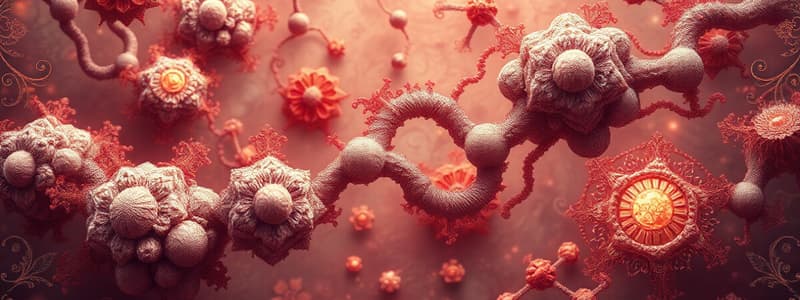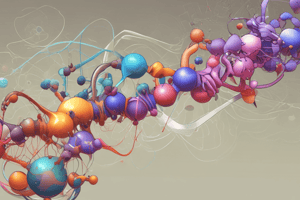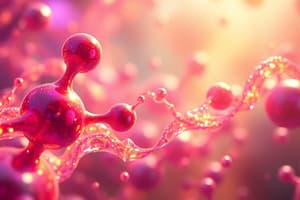Podcast
Questions and Answers
Explain the concept of 'steady-state approximation' in Michaelis-Menten kinetics, and why it is crucial for deriving the Michaelis-Menten equation.
Explain the concept of 'steady-state approximation' in Michaelis-Menten kinetics, and why it is crucial for deriving the Michaelis-Menten equation.
The steady-state approximation assumes that the concentration of the enzyme-substrate complex [ES] remains constant over time during the reaction. This assumption is crucial because it simplifies the rate equations, allowing for the derivation of the Michaelis-Menten equation, which relates reaction velocity to substrate concentration.
How does competitive inhibition affect the apparent $K_m$ and $V_{max}$ of an enzymatic reaction? Explain the mechanism behind these changes.
How does competitive inhibition affect the apparent $K_m$ and $V_{max}$ of an enzymatic reaction? Explain the mechanism behind these changes.
Competitive inhibition increases the apparent $K_m$ (decreases the enzyme's affinity for the substrate) but does not affect $V_{max}$. A competitive inhibitor binds to the active site, preventing substrate binding. Higher substrate concentrations can outcompete the inhibitor, allowing the reaction to still reach the same $V_{max}$.
Describe the difference between ordered and random sequential bisubstrate reactions in enzyme kinetics. Provide a brief example to illustrate.
Describe the difference between ordered and random sequential bisubstrate reactions in enzyme kinetics. Provide a brief example to illustrate.
In ordered sequential reactions, substrates must bind to the enzyme in a specific order before the reaction can occur. In random sequential reactions, the order of substrate binding is not important. For example, lactate dehydrogenase (LDH) exhibits ordered sequential binding (NAD+ first), while creatine kinase exhibits random sequential binding.
Explain the 'ping-pong' mechanism in enzyme kinetics. What distinguishes it from sequential mechanisms, and give an example of an enzyme that follows this mechanism?
Explain the 'ping-pong' mechanism in enzyme kinetics. What distinguishes it from sequential mechanisms, and give an example of an enzyme that follows this mechanism?
How does the catalytic efficiency ($k_{cat}/K_m$) reflect an enzyme's overall ability to catalyze a reaction? What are the theoretical limits on catalytic efficiency, and why do they exist?
How does the catalytic efficiency ($k_{cat}/K_m$) reflect an enzyme's overall ability to catalyze a reaction? What are the theoretical limits on catalytic efficiency, and why do they exist?
Describe how temperature affects the rate of diffusion, and what is the relationship per the Arrhenius equation?
Describe how temperature affects the rate of diffusion, and what is the relationship per the Arrhenius equation?
Explain how the size and shape of a molecule affect its diffusion coefficient. Provide an example of two molecules with different diffusion coefficients based on these factors.
Explain how the size and shape of a molecule affect its diffusion coefficient. Provide an example of two molecules with different diffusion coefficients based on these factors.
What is the physical significance of the principal quantum number (n) in the context of atomic structure?
What is the physical significance of the principal quantum number (n) in the context of atomic structure?
Explain the concept of blackbody radiation and how it challenged classical physics. What key idea did Planck introduce to resolve this issue?
Explain the concept of blackbody radiation and how it challenged classical physics. What key idea did Planck introduce to resolve this issue?
Describe the photoelectric effect and explain how it provides evidence for the particle-like nature of light. What is the role of the work function in this phenomenon?
Describe the photoelectric effect and explain how it provides evidence for the particle-like nature of light. What is the role of the work function in this phenomenon?
What is the de Broglie wavelength, and how does it relate to the momentum of a particle? Explain its significance in understanding the wave-particle duality.
What is the de Broglie wavelength, and how does it relate to the momentum of a particle? Explain its significance in understanding the wave-particle duality.
Explain the key differences between the Bohr model of the atom and the quantum mechanical model. What limitations of the Bohr model are addressed by the quantum mechanical model?
Explain the key differences between the Bohr model of the atom and the quantum mechanical model. What limitations of the Bohr model are addressed by the quantum mechanical model?
What is a mathematical operator in quantum mechanics, and how is it used to extract information about a quantum system? Give an example of an operator and what physical property it represents.
What is a mathematical operator in quantum mechanics, and how is it used to extract information about a quantum system? Give an example of an operator and what physical property it represents.
Explain the Heisenberg uncertainty principle. How does it fundamentally limit the precision with which we can know certain pairs of physical properties, such as position and momentum?
Explain the Heisenberg uncertainty principle. How does it fundamentally limit the precision with which we can know certain pairs of physical properties, such as position and momentum?
What is the physical interpretation of the wavefunction, $\psi$, in quantum mechanics? How is the probability of finding a particle in a specific region of space related to the wavefunction?
What is the physical interpretation of the wavefunction, $\psi$, in quantum mechanics? How is the probability of finding a particle in a specific region of space related to the wavefunction?
Flashcards
Enzymes
Enzymes
Substances that speed up chemical reactions without being consumed in the process.
Catalytic Efficiency
Catalytic Efficiency
A measure of how effectively an enzyme converts substrate to product.
Enzyme Inhibitors
Enzyme Inhibitors
Substances that reduce enzyme activity by binding to the enzyme or enzyme-substrate complex.
Uncompetitive Inhibition
Uncompetitive Inhibition
Signup and view all the flashcards
Non-Competitive Inhibition
Non-Competitive Inhibition
Signup and view all the flashcards
Ping-Pong Mechanisms
Ping-Pong Mechanisms
Signup and view all the flashcards
Passive Diffusion
Passive Diffusion
Signup and view all the flashcards
Active Transport
Active Transport
Signup and view all the flashcards
Flux
Flux
Signup and view all the flashcards
Degrees of Freedom
Degrees of Freedom
Signup and view all the flashcards
Blackbody Radiation
Blackbody Radiation
Signup and view all the flashcards
Photoelectric effect
Photoelectric effect
Signup and view all the flashcards
De Broglie Wavelength
De Broglie Wavelength
Signup and view all the flashcards
Wave Function
Wave Function
Signup and view all the flashcards
Heisenberg Uncertainty Principle
Heisenberg Uncertainty Principle
Signup and view all the flashcards
Study Notes
Chapter 8: Enzyme Catalysis and Kinetics
- Enzymes act as catalysts in complex biochemical processes, enhancing enzyme kinetics and transport.
- Enzymes provide an alternate reaction pathway, lowering the activation energy (Ea), leading to a faster reaction rate.
- The Arrhenius equation describes the relationship between the rate constant (k) and activation energy: k = A exp(-Ea/RT)
- A represents the collision frequency or pre-exponential factor
Catalysts: Heterogeneous vs. Homogeneous
- Heterogeneous catalysts exist in a different phase from the reactants/substrate.
- Purification and isolation are easier
- Slower reaction rates
- Harder to study.
- Homogeneous catalysts exist in the same phase as the reactants/substrate.
- For example, catalyst dissolved in the same solvent as the substrate
- More difficult to purify/isolate
- Faster reaction rates
- Easier to study.
Examples of Catalysts
- Catalytic converters in cars:
- Oxidation: 2 CO + O2 -> 2 CO2
- Reduction: 2 NOx -> x O2 + N2
- CO and NOx contribute to smog; reactions occur on surfaces.
- Catalytic converters complete combustion of uncombusted products via platinum on tubes
- Ziegler-Natta Polymerization Catalysts:
- TiCl4 + AlEt3 catalyze the polymerization of >90% of PE and PP plastics.
- Enzymes:
- Work with substrates in water and release products into water.
- Act on substrates.
- Decomposition of Hydrogen Peroxide:
- Uncatalyzed: Ea = 76 kJ/mol.
- With I-: Ea = 57 kJ/mol.
- With catalase: Ea = 8 kJ/mol.
Michaelis-Menten (Enzyme) Kinetics
- Enzymes are homogeneous catalysts that act on substrates.
- Initial rate is proportional to enzyme concentration [E]₀ for a given [S]₀.
- Rate is proportional to substrate concentration [S]₀ for a given [E]₀ and low [S]₀.
- Rate is independent of [S]₀ for a given [E]₀ and high [S]₀, reaching maximum velocity (Vmax).
- Product inhibition can occur.
- Reaction Scheme: E + S ⇌ ES -> E + P, where E is the enzyme, S is the substrate, ES is the enzyme-substrate complex, and P is the product.
- d[P]/dt = k₂[ES], where k₂ is the rate constant for the formation of product.
- Steady-State Approximation:
- Assumes the intermediate concentration (ES) becomes constant.
Key Equations and Relationships
- KM = (k-₁ + k₂)/k₁ = [E][S]/[ES]
- [S] is usually in large excess: [S]₀ >> [E]₀, [ES]
- When [S]₀ is much greater than [E]₀ and [ES], [E] = [E]₀ - [ES] and [S] = [S]₀ - [ES] ≈ [S]₀
- Reaction velocity: v = (k₂[E]₀[S]₀) / (KM + [S]₀)
- At Vmax, all enzyme molecules are complexed with substrate, so [E]₀ = [ES].
- Low [S]₀: v approaches (Vmax/[KM]) [S]₀.
- When [S]₀ << KM, v is proportional to [S]₀.
Vmax and Catalytic Efficiency
-
High [S]₀: v approaches Vmax = k₂[E]₀.
-
KM: Binding affinity of enzyme for substrate.
- Small KM means tight binding of S to E, high affinity, and less S is needed to saturate E, leading to Vmax
-
kcat (Turnover frequency): Number of substrate molecules converted to product per enzyme molecule per unit time
- kcat = Vmax / [E]₀, where [E] is the enzyme concentration.
-
Catalytic Efficiency (η):
- η = kcat/KM = (k₁k₂) / (k₋₁ + k₂)
- When k₂ >> k₋₁, η approaches k₁, indicating maximum efficiency.
- k₁ represents the rate of E and S diffusing to each other, proportional to diffusion coefficient.
Enzyme Inhibition: Types and Mechanisms
- Inhibitors slow down enzymes by binding to E or ES, blocking product formation/release.
- Direct Inhibition: E + I ⇌ EI
- KI = [E][I]/[EI]
- Inhibition After ES Complex Formation: ES + I ⇌ ESI
- K'I = [ES][I]/[ESI]
- When KI gets really small favors the products- tight binding and is a more effective inhibitor.
Uncompetitive Inhibition
- Inhibitor (I) binds to the ES complex away from active site.
- Parallel lines on Lineweaver-Burk plot; slope remains unchanged (α' = 1)
- Affects both KM and Vmax to the same degree.
- V = Vmax/[α'(1 + (KM/[S]₀))]
Competitive Inhibition
- Inhibitor (I) competes with substrate (S) for the active site.
- Lineweaver-Burk plot passes through the y-intercept, but has a different slope (α > 1)
- v = Vmax / [(1 + α(KM/[S]₀))]
- α = 1 + ([I]/KI), affects the slope of the Lineweaver-Burk plot.
Non-Competitive Inhibition
- Inhibitor (I) binds to either E or ES (α and α') away from the active site.
- Affects both KM and Vmax .
- Changes both the y-intercept and slope on a Lineweaver-Burk plot (α = α' > 1)
Sequential Reactions
- Two or more substrates bind to the enzyme in a specific order before the reaction can occur.
- Random Binding: Two more equilibria have to be included
- (3) E+S2 ⇌ ES2 with KM2 = ([E][S2])/[ES2] (4) ES2 + S1 ⇌ ES1S2 with KM21 = ([ES2][S1])/[ES1S2]
- Ethylene Biosynthesis by ACC Oxidase:
- Fe2+ + O2 -> Fe3+ + O2*-
- Fe3+ + O*- -> Fe4= + O2-
- Ordered Binding E+S1⇌ ES1. KM1=([E][S1])/[Es1]
- *S2 only binds to Es1 Es1+ S2⇌ ES1S2. Km12 =([E][S1][S2}])/[ES1S2]
Ping Pong Reactions
- Two substrates yield two products, where two different "states" of the enzyme react, one with each substrate.
- Includes proteases and Reactive Oxygen Species (ROS) determining enzymes.
- Superoxide Dismutase:
- O2- + E -> O2 + E* (transfer one electron)
- E* + O2- -> O2 + E (accept electron)
Transport: Passive vs. Active
- Controlled by diffusion.
- Passive: Diffusion along a concentration gradient.
- Active: ATP-driven diffusion against the concentration gradient.
Diffusion Rates and Factors
- Rate of diffusion is directly proportional to flux -# of particles areaxtime = -D dc/dx = amnt material /unit time/unit length - D=system-specific diffusion coefficient -conc-gradient
- Examples of Diffusion Rates:
- Glycine in water: 1.06 m²/s
- H₂O in water: 2.20 x 10⁻⁹ m²/s
- Sucrose in water: 0.52 m²/s
- Proteins in water: 0.04-0.10 m²/s (20 nm)
- Viruses in water: 0.01 m²/s (1000 nm)
Stokes-Einstein Equation:
- States D=kT/6πna = gives direct correlation to molecular size
- η is viscosity, a particle radius which as radius increases D decreases
Electrophoresis
- Based on particles that also diffuse based on charge.
- Protein/DNA: negative charge soluble in eater
- Move toward opposite pole at its drift velocity-> u (voltage applied)/L
- Ohm's Law/Equation: Mobility u radius a- a mobility radius
Studying That Suits You
Use AI to generate personalized quizzes and flashcards to suit your learning preferences.




